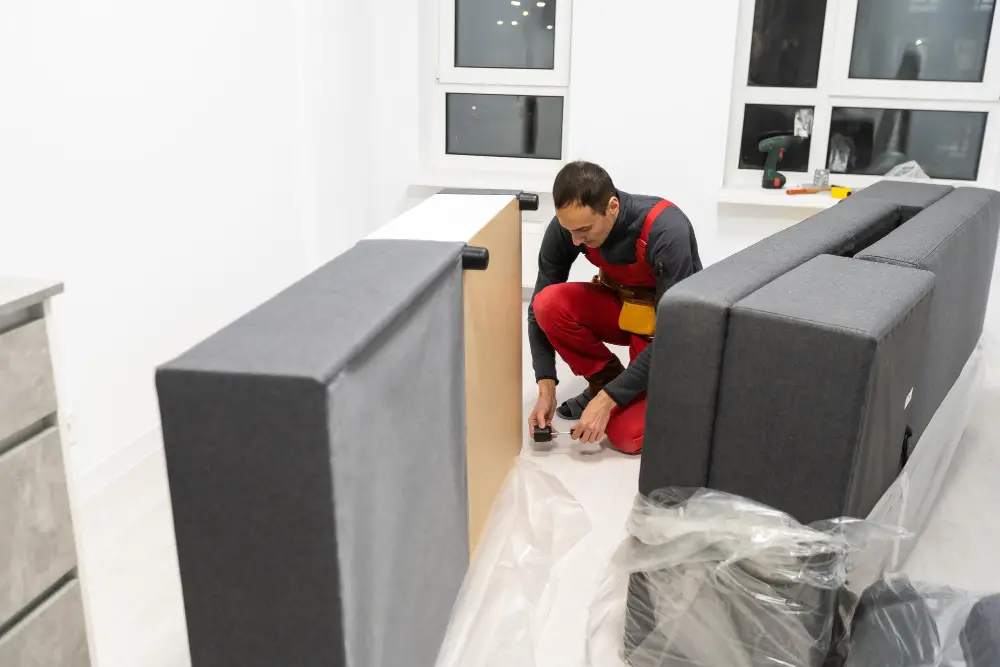Last updated on
Discover the most effective way to store your couch in a storage unit, ensuring it remains in top condition and ready for future use.
Are you planning to store your couch in a storage unit? Whether you’re moving, downsizing, or simply need extra space, storing furniture can be a challenge. But fear not! With the right preparation and techniques, you can easily store your couch safely and securely.
In this article, we’ll provide you with practical tips on how to store a couch in a storage unit without causing any damage or wear and tear. So let’s get started!
Key takeaways:
- Choose the right storage unit: Consider location, security, and size.
- Measure the couch: Accurately measure the dimensions for a proper fit.
- Prepare the couch for storage: Remove cushions, vacuum, and clean stains.
- Disassemble the couch: Take apart detachable legs, arms, and recliner features.
- Use covers and elevate the couch: Protect with plastic wrap or furniture covers, and elevate with a pallet or platform.
Table of Contents
Choosing the Right Storage Unit

The first step in storing your couch is to choose the right storage unit. When selecting a storage facility, consider factors such as location, security features, and accessibility.
You want to ensure that the unit you choose is clean and dry with adequate ventilation to prevent mold or mildew growth on your furniture.
It’s also important to think about the size of the storage unit you’ll need for your couch. Measure both the length and height of your sofa before choosing a space so that it fits comfortably without being cramped or damaged by other items stored nearby.
Another factor worth considering when choosing a storage facility is whether it offers climate-controlled units. Climate control can help protect against extreme temperatures and humidity levels which can cause damage over time.
Measure the Couch

This will help you determine the right storage unit size and ensure that the couch fits comfortably inside without any damage or scratches. Measure the length, width, and height of your couch accurately using a tape measure.
Don’t forget to include any protruding parts such as legs or armrests in your measurements.
Once you have measured your couch, compare its dimensions with those of different storage units available at the facility where you plan to store it. Choose a unit that provides enough space for both storing other items alongside your sofa and allowing easy access when needed.
Preparing the Couch for Storage

This will help prevent any damage or wear and tear during the storage period. The first step is to remove all cushions and pillows from the couch.
These should be stored separately in plastic bags or boxes.
Next, vacuum the entire surface of your couch thoroughly using an upholstery attachment to remove any dust, dirt, or debris that may have accumulated over time.
If there are any stains on your sofa fabric, clean them with a suitable cleaner before storing it away. Be sure to follow manufacturer instructions for cleaning products as some can cause discoloration if not used correctly.
Check for loose screws or bolts on the frame of your sofa and tighten them up if necessary. This will ensure that no parts come apart during transportation or while being stored in a unit.
Disassembling the Couch

This step is crucial as it will help you save space and prevent any damage during transportation. Start by removing all the cushions from the couch and set them aside.
Next, remove any detachable legs or arms that can be unscrewed easily.
If your couch has a recliner feature or other moving parts, make sure to follow manufacturer instructions on how to disassemble these components properly. Keep all screws and bolts in labeled bags so that you don’t lose them.
By taking apart your sofa before storing it away, you’ll have an easier time fitting everything into your storage unit while also reducing its overall size for better protection against potential damages during transport or while stored away long-term.
Cleaning Your Couch

Dirt and dust can accumulate on the surface of the couch over time, leading to discoloration or even mold growth. To prevent this from happening, vacuum your couch using an upholstery attachment to remove any loose dirt or debris.
For stains and spills on fabric sofas, use a mild detergent mixed with warm water and a soft-bristled brush to gently scrub away the stain. Avoid using harsh chemicals that could damage the fabric.
Leather sofas require special care when cleaning as they are more delicate than other materials. Use a leather cleaner specifically designed for furniture and follow instructions carefully.
Protecting the Couch With Covers

This step is crucial in preventing dust, dirt, and moisture from damaging the fabric or leather of your couch. You can use plastic wrap or a specially designed furniture cover for this purpose.
Plastic wrap is an affordable option that provides a tight seal around the entire couch. However, be sure not to leave any part of the plastic touching the surface of your sofa as this could cause condensation buildup leading to mold growth.
On the other hand, furniture covers are made from breathable materials such as cotton or canvas that allow air circulation while keeping out dust and debris. They come in various sizes depending on your needs but make sure you choose one that fits snugly over all parts of your sofa.
Storing Cushions Separately

Leaving them on the couch can cause them to lose their shape and become misshapen over time. To avoid this, remove all cushions from your couch before placing it in storage.
Once you’ve removed the cushions, store them separately from your sofa. You can place them in large plastic bags or wrap each cushion individually with bubble wrap or packing paper for added protection against dust and moisture.
If you have multiple sets of cushions for different seasons or occasions, label each set clearly so that they’re easy to identify when you need to retrieve them later on.
Using a Pallet or Platform

By elevating the couch off the ground, you can prevent it from coming into contact with any dampness that may be present on the floor of your storage unit. This method also allows for better air circulation around your furniture, which helps to keep it fresh and dry.
When using a pallet or platform, make sure that it’s sturdy enough to support the weight of your couch. You can purchase pre-made platforms at most home improvement stores or build one yourself using wooden planks.
To use this method effectively, place four evenly spaced blocks on top of each corner of the pallet or platform. Then carefully lift and place your couch onto these blocks so that its weight is distributed evenly across them.
Preparing a Spot to Store Your Couch in Storage

This will help ensure that your couch remains in good condition while in storage and is easy to retrieve when you need it again.
First, make sure the area where you plan to store your couch is clean and dry. Sweep or vacuum any debris from the floor and wipe down any surfaces with a damp cloth.
Next, consider placing a tarp or plastic sheeting on the floor of your storage unit before moving in your furniture. This can help protect against moisture that may seep up from concrete floors.
It’s also important to think about how accessible you want your stored items to be. If possible, choose an area near the front of the unit so that retrieving items later will be easier.
Take note of any potential hazards such as low-hanging lights or pipes overhead which could damage furniture during transport into or out of storage units.
Move the Couch Into the Unit

This step requires some planning and effort to ensure that your couch remains in good condition during transport.
Firstly, make sure you have enough people to help with moving the couch. Depending on its size and weight, you may need two or more people.
It’s also a good idea to use furniture sliders or dollies if possible.
When moving the couch into the unit, be careful not to drag it along any surfaces as this can cause damage or scratches. Instead, lift one end of the sofa at a time while keeping it level so that no part of it is dragging on anything.
Once inside your storage space, position your sofa against a wall where there is plenty of room around all sides for ventilation purposes (if applicable). Avoid placing other items directly next to or on top of your stored sofa as this could cause damage over time.
Positioning the Couch in Storage

The best way to do this is by placing the couch against a wall or in a corner of the unit. This will help prevent any accidental damage from other items being stored in the same space.
It’s also essential to make sure that there is enough space around your couch for air circulation and easy access when you need to retrieve it later on. Avoid positioning your furniture too close together or stacking boxes on top of them as this can cause scratches, dents, and even mold growth due to lack of ventilation.
If possible, try not to place anything heavy on top of your sofa as this could cause permanent damage over time. Instead, consider using shelves or racks above and beside your furniture for additional storage options.
Keeping Distance From Walls

This will help prevent any moisture buildup or mold growth on your furniture. Ideally, you should leave at least 2-3 inches of space between the back of your couch and any wall.
If possible, try to position your couch away from exterior walls that may be exposed to temperature fluctuations or humidity changes. If this is not feasible due to limited space in the storage unit, consider using a dehumidifier or placing moisture-absorbing packets near the stored items.
Ventilation and Humidity Considerations
Poor ventilation can cause musty odors and mold growth on your furniture, while high humidity levels can lead to warping or cracking of wooden frames.
To ensure proper air circulation, avoid placing your couch directly against walls or other items in the storage unit. Leave some space between each item for air to flow freely around them.
If you live in an area with high humidity levels or plan on storing your couch for an extended period of time, consider investing in a dehumidifier for added protection against moisture damage.
Avoid Stacking Items On Top of Your Couch
Placing heavy boxes or other furniture on top of the couch can cause damage and deformations that may be difficult to repair. If you stack items too high, they could fall over and damage your couch.
To prevent this from happening, make sure you position the couch in a way that allows for enough space around it so that nothing is touching or leaning against it. If you need to store additional items above the height of your sofa cushions, consider using shelving units instead.
Stacking and Storing Other Items

If you plan on stacking boxes or other furniture on top of your couch, make sure they are lightweight and won’t cause any damage. Avoid placing heavy objects or sharp-edged items that could scratch or puncture the fabric.
It’s also essential to ensure that nothing is leaning against the couch for an extended period as this can cause permanent indentations in cushions and upholstery.
If possible, store larger items such as dressers and bookcases vertically along walls rather than horizontally across from where your sofa will be stored. This way, there will be no risk of them falling over onto your precious piece during retrieval.
Securing the Stored Couch
This will prevent any accidental movement or damage while in storage. One way to do this is by using straps or ropes to tie down the couch securely.
Make sure that these are not too tight as they can cause dents and creases on your furniture.
Another option is placing heavy items around the couch, such as boxes filled with books or other sturdy objects, which will help keep it from shifting during transport and while stored.
If you’re storing a sectional sofa with detachable pieces, make sure each piece is secured separately before leaving them unattended for an extended period of time.
Regularly Inspecting the Couch

This will help you identify any potential issues before they become major problems. Check for signs of moisture, mold or mildew growth, and pests such as rodents or insects that may have made their way into the unit.
Inspecting your couch every few months is recommended to ensure its condition remains intact while in storage. If possible, remove the covers and cushions from the couch during inspection so that you can check all areas thoroughly.
If there are any signs of damage or wear and tear on your couch during an inspection visit, take immediate action to address them before they worsen over time. You may need professional assistance if there is significant damage.
Renters Insurance for Storage Units

While most storage facilities have security measures in place, such as surveillance cameras and gated access, accidents can still happen. Renters insurance can provide peace of mind knowing that your belongings are protected against theft or damage.
When choosing a renters insurance policy for your stored items, make sure to read the fine print carefully and understand what is covered under the policy. Some policies may not cover certain types of damage or loss.
Some storage facilities may require proof of renters insurance before allowing you to rent a unit. Be sure to check with the facility beforehand so you’re prepared with all necessary documentation.
Taking steps like choosing the right storage unit size and location along with preparing furniture properly will help ensure that your couch remains safe while in self-storage units.
Consider a Climate-Controlled Storage Unit

These units are designed to maintain a consistent temperature and humidity level, which can help prevent damage caused by extreme weather conditions. Climate-controlled units are particularly useful if you live in an area with high humidity or frequent temperature fluctuations.
A couch is made up of various materials that can be affected by changes in the environment. For example, leather furniture may crack or warp when exposed to heat and moisture over time.
Similarly, wooden frames may expand or contract due to changes in temperature and humidity levels.
By choosing a climate-controlled storage unit, you’ll have peace of mind knowing that your couch is protected from these environmental factors. The controlled environment will also help prevent mold growth on fabric upholstery caused by excess moisture.
Retrieving the Couch From Storage

The process is relatively simple and straightforward. First, make sure that you have access to the storage unit during its operating hours.
Then, remove any items that may be blocking your way or preventing easy access to the couch.
Next, carefully move any other stored items out of the way before retrieving your couch from its spot in storage. If necessary, bring along some help for lifting and carrying heavy furniture.
Once you’ve retrieved your couch from storage and moved it back into place at home or wherever else it’s needed, take a moment to inspect it for any damage or wear caused by being stored away.
By following these steps for retrieving a stored couch safely and efficiently while taking care not to cause damage during transport back home – you can ensure that this valuable piece of furniture remains in top condition even after spending time away from regular use!
FAQ
Is it OK to put couch in storage unit?
Yes, it is OK to put a couch in a storage unit, but ensure there is at least 10 centimeters of space from an exterior wall to allow for proper air flow and fabric breathability.
Should I wrap my sofa for storage?
Yes, you should wrap your sofa for storage using blankets and a layer of plastic wrap to protect it from damage.
Should I wrap my couch in plastic for storage?
Yes, you should wrap your couch in plastic or other protective materials for storage to ensure its protection during the moving, packing, and storage process.
How do you keep furniture from molding in storage?
To prevent furniture from molding in storage, pack possessions in waterproof boxes or use silica gel, and invest in a moisture-resistant storage unit.
What is the ideal climate condition for storing a couch in a storage unit?
Ideal climate condition for storing a couch in a storage unit is a dry, cool, and well-ventilated space to prevent mold, mildew, and damage to the material.
How can I disassemble and reassemble a couch for efficient storage?
To disassemble and reassemble a couch for efficient storage, carefully remove the cushions, detach the frame and legs by unscrewing connectors, and then reassemble the pieces in the reverse order when needed.
What precautions should I take to protect my couch from pests while in storage?
To protect your couch from pests while in storage, ensure it’s clean, use a furniture cover, and place it on a raised surface in a climate-controlled environment.





